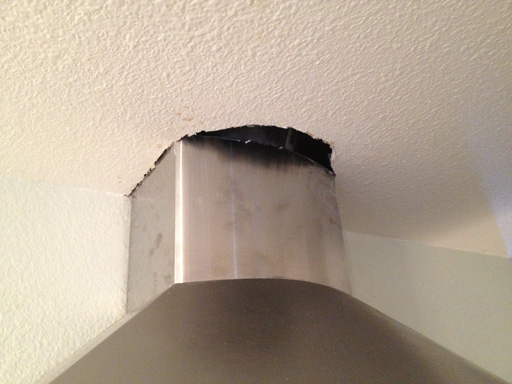Our new range hood vent is smaller than the hole used by our old microwave’s exhaust duct. Here’s the problem: a 5” wide x 2” deep gap adjacent to the range hood’s ventilation duct.
Here’s what didn’t work
Bad Idea #1): Curved piece for curved hole
I wish I’d thought to try this before I cut the darn piece out: the anchor wood won’t fit into the hole with enough space for my fingers to hold it down while I drill it into place.

This strip of wood has to straddle the hole – and my fingers need to hold it down. There’s no room for my fingers.
Solution: I made the hole bigger (and rectangular).

Obviously, the solution is to make my ceiling hole even larger. (I did this when no one else was home to question my methodology, which was smart because this must have looked insane.)
Anyway, I was trucking along with this bigger/more rectangular hole. I even found a thicker “anchor strip” of wood (if there’s a technical term for this, I don’t know it) to use.
And that’s about when Bad Idea #2 revealed itself: The new patch piece? Yeah, it’s 1/4” thicker than the ceiling’s drywall. There’s no way to “gloss over” this – I need to find thinner drywall, and cut another freaking piece (~20 minutes of cutting and shaving).
I can’t believe it didn’t occur to me that the piece I was making was hella thick:
Anyway, I found a thinner scrap and cut another piece. This time, it was the right thickness, the right shape, and I was able to anchor it to my “anchor wood”.
Sweet! I began smoothing everything over with a few layers of spackle. Texture and painting will come later, once this has dried.
Something that isn’t obvious from these photos is the absolutely awkward angle I was working at. The range hood is large, and the ceiling is low once I’m on the ladder, so I did most of this work bent at the waist with my head pressed against the ceiling, sideways, while standing on a stepladder. Glad this one’s done!










Looks like crap, no offence, I hope you didn’t leave it like that last photo.
Haha, thanks for stopping by – no, I finished it with a texture spray, a thin line of caulk between the patch and the duct cover, and a new coat of ceiling paint over the whole thing. Dunno why I didn’t mention that in the original article or include an “after”, but I’ve since sold the house so it’s too late to take one now. XD